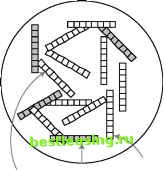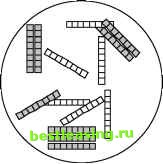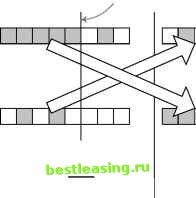

 |
 |

|
Промышленный лизинг
Методички
generation n  this genome dies off this genome multiplies this genome survives crossover position generation n + 1  Selection keeps the size of the population constant but increases the fitness of the next generation. Genomes with a higher fitness (darker shading) proliferate and genomes with lighter shading die off.  Crossover is a way of combining two genomes. A crossover position determines where the genomes break and are recombined. mutation Mutation makes an occasional random change to a random position in a genome. This allows features to appear that may not have been in the original population. Figure 13.2 The basic operators in genetic algorithms are selection, crossover, and mutation. SIMPLE OVERVIEW OF GENETICS Life depends on proteins, which consist of sequences of 20 basic units called amino acids. The chromosomes in the nucleus of a cell are strands of DNA (deoxyribonucleic acid) that carry the blueprints for the proteins needed by the cell. The 23 chromosomes in each human cell together are the genome for that individual. In general, the genomes of different individuals in a species are very similar to each other; however, there are some individual differences. The DNA in the genome encodes these blueprints for the amino acids sequences using strands of nucleotides. These nucleotides constitute the four letters of the genetic alphabet: ♦ A, adenine ♦ C, cytosine ♦ G, guanine ♦ T, thymine Triplets of nucleotides represent the 20 amino acids. For instance, the amino acid called methionine corresponds to the triplet ATG. Another amino acid, lysine, has two spellings : AAA and AAG. So, if a strand of DNA contains the following letters: ATGAAGATGCGA then it decodes into a protein containing four amino acids: methionine, ATG; lysine, AAG; methionine, ATG; followed by arginine, CGA (see figure). This description intentionally glosses over the details of the actual biochemical mechanism that turns the blueprints into proteins, but it provides a high-level outline of the mapping from genetic information in DNA to the building blocks of proteins. A biological example of encoding is the mapping from nucleotides in DNA to amino acids in protein. In this simplified model, the process of evolution works as follows. The proteins produced by the representations in the DNA express themselves as features of the living organism, such as blue eyes, five fingers, the structure of the brain, a long trunk, and so on. Genes can express themselves in damaging ways, causing the resulting organism to die. Healthy organisms survive to produce offspring and pass their DNA to the next generation. In higher-level animals, the DNA is actually combined with the DNA from another survivor during sexual replication, using a technique called crossover. Sometimes, mistakes are made in passing genes from one generation to the next-these are mutations. The combination of all these processes over the course of many generations results in organisms highly adapted to their environment: the process of evolution. SIMPLE OVERVIEW OF GENETICS (continued) DNA with Amino Acids Nucleotides for Proteins Adenine Thymine Guanine Adenine Adenine Guanine Adenine Thymine Guanine C ytosine Guanine Methionine Lysine Methionine Arginine 1 2 3 4 5 6 7 8 9 10 11 12 13 14 15 16 17 18 19 20 21 22 23 24 25 26 27 28 29 30 31 32 33 34 35 36 37 38 39 40 41 42 43 44 45 46 47 48 49 50 51 52 53 54 55 56 57 58 59 60 61 62 63 64 65 66 67 68 69 70 71 72 73 74 75 76 77 78 79 80 81 82 83 84 85 86 87 88 89 90 91 92 93 94 95 96 97 98 99 100 101 102 103 104 105 106 107 108 109 110 111 112 113 114 115 116 117 118 119 120 121 122 123 124 125 126 127 128 129 130 131 132 133 134 135 136 137 138 139 140 141 142 143 144 145 146 147 148 149 [ 150 ] 151 152 153 154 155 156 157 158 159 160 161 162 163 164 165 166 167 168 169 170 171 172 173 174 175 176 177 178 179 180 181 182 183 184 185 186 187 188 189 190 191 192 193 194 195 196 197 198 199 200 201 202 203 204 205 206 207 208 209 210 211 212 213 214 215 216 217 218 219 220 221 222 |